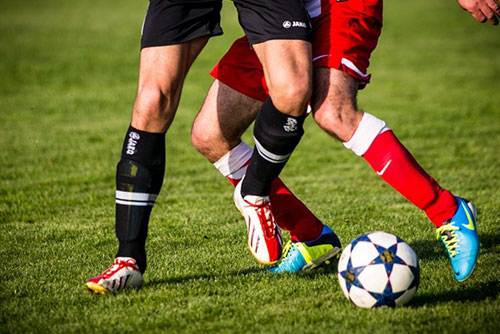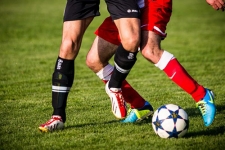
As discussed previously, an overuse injury is any type of injury that is caused by repetitive trauma and includes injuries like stress fractures and tendinitis. Overuse injuries tend to occur because of training errors. Some of the most common lower body overuse injuries include:
Knee – Regardless of the sport (baseball, tennis, football, softball, volleyball, running, rugby, soccer, etc), knee injuries are quite common. Athletes are extremely susceptible to knee injuries due to the amount of running, jumping, and sudden starts and stops that are required in training and competition. For instance, patellar tendonosis (aka, Jumper’s Knee) is an inflammation of the patellar tendon that connects the kneecap to the shin bone. ACL injuries are also very common, with over half coming from non-contact cutting.
Shins – Shin splints are extremely common and can affect players in all sports. The pain associated with shin splints is due to inflammation of the tissues surrounding the tibia (shin bone) and is caused by a multitude of factors including poor flexibility; repetitive contact on hard surfaces; and, rapid increases in training. Early on, shin splints are felt as tenderness to the shin(s), especially when the foot is bent downwards. As the damage continues, the pain will increase to a point where movement is hindered greatly. Rest, ice, and massage therapy – in conjunction with proper flexibility and strength training – is the typical treatment for shin splints.
Achilles Tendon – Achilles tendonitis is an acute, inflammatory stress injury of the Achilles tendon. Athletes suffering from this condition will experience pain before, during, and after activity, and those with weak calf muscles (or other strength and/or flexibility imbalances) are at increased risk caused by repeated micro-tears in the Achilles tendon, damaging healthy tissue (sometimes permanently). If left untreated, the degeneration of healthy tissue (in conjunction with the increased presence of scar tissue) turns into Achilles tendonosis. When the inflammatory process leads to healthy healing and to the resolution of the injury, tendonitis does not progress to tendinosis. Tendons, however, usually require a long time to heal; their poor blood supply coupled with ongoing activities such as running puts continued stress along the tendon, slowing the healing process further and contributing to the degenerative condition of the tendon known as tendinosis. While tendonitis and tendinosis can develop almost anywhere from head to toe, the Achilles tendon is a very common problem area for athletes including soccer players and one which should be appropriately addressed once symptoms appear.
Hips and Thighs – Hip injuries (while common in all sports) are especially common in athletes who perform high intensity, repetitive hip movements (track, gymnastics, etc). Femoral neck stress fractures (which affect the top portion of the thigh bone) are due to a multitude of factors including poor running mechanics, excessive training, or the increasing of a training schedule too quickly. Femoral neck stress fractures are often felt as groin pain, which progresses in intensity as the injury progresses. “Snapping hip syndrome” is another common hip ailment and causes tendons to painfully (and audibly, hence the name) “snap” over the bones around the hip joint. Core and pelvic strengthening are both integral to the prevention of overuse injuries of the hip.
As you can see, there are a LOT of different types of overuse injuries that can occur. If you’re concerned about joint or muscle pain and/or weakness that you’ve been experiencing, please don’t hesitate to give Prairie Orthopaedic and Plastic Surgery a call. Dr. Hurlbut and Dr. Krejci – as well as our highly skilled team of physical therapists – are here to get you back on the road to recovery!

